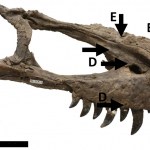theropods
The number one rule of the Taphonomy Club is don't talk about marks on bones ... without placing them in context. Many marks on bones could have multiple causes, such as putative cut marks caused by stone tools on animal bones found on early hominid sites. In that case, hard sharp stony objects in the ground can cause marks that are hard to tell apart from stone tool marks. But when you find almost all the possible stone tool marks in the exact locations they would be if a hominid was butchering or defleshing the animal, then you can assert that that butchery or defleshing with stone tools…
tags: evolution, evolutionary biology, UV light, flight, dinosaur, dromaeosaur, theropods, Microraptor gui, paleontology, fossils, birds, researchblogging.org,peer-reviewed research, peer-reviewed paper, journal club
Figure 1. The holotype of Microraptor gui, IVPP V 13352 under normal light. This shows the preserved feathers (white arrow) and the 'halo' around the specimen where they appear to be absent (black arrows). Scale bar at 5 cm. [larger view]
DOI: 10.1371/journal.pone.0009223
It has long been known that when exposed to ultraviolent light, fossilized bones and shells -- and even…
tags: evolutionary biology, convergent evolution, paleontology, taxonomy, zoology, basal birds, theropods, dinosaurs, ornithology, birds, Alvarezsauroidea, Haplocheirus sollers, Maniraptora, Archaeopteryx, researchblogging.org,peer-reviewed research, peer-reviewed paper
A Newly Discovered Basal Alvarezsauroid Theropod from the Early Late Jurassic.
Artwork: Portia Sloan [larger view]
DOI: 10.1126/science.1182143
A long-standing scientific debate focuses on the origins of birds: did they evolve from reptiles or dinosaurs? Currently, most scientists think that birds are modern dinosaurs,…
tags: evolutionary biology, fossils, feathers, plumage color, color, dinosaurs, theropods, Sinosauropteryx, Sinornithosaurus, birds, Confuciusornis, melanosomes, phaeomelanosomes, eumelanosomes, keratinocytes, SEM, scanning electron microscopy, 10.1038/nature08740, researchblogging.org, peer-reviewed research, peer-reviewed paper
Reconstruction of two Sinosauropteryx, sporting their orange and white striped tails.
Artwork by Chuang Zhao and Lida Xing [larger view]
DOI: 10.1038/nature08740
While looking at museum dioramas that feature dinosaurs, I often overhear people asking "How do they…
